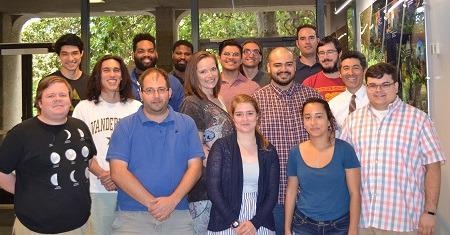A group of astronomers discovered a once-in-a-lifetime discovery that will help address long-standing mysteries about the development of stars. Keivan Stassun, a member of the Evolutionary Studies Initiative and a Stevenson Professor of Physics and Astronomy, headed the group.
 The Stassun lab – 2018. Image Credit: Vanderbilt University.
The Stassun lab – 2018. Image Credit: Vanderbilt University.
In 2017, Stassun’s team developed a new model that vastly improved how stars are measured.
Being able to combine all of the different types of measurements into one coherent analysis was certainly key to being able to decipher the various unusual characteristics of this star system.
Keivan Stassun, Stevenson Professor, Physics and Astronomy, Vanderbilt University
The model aids in the prediction of exoplanets, or planets circling distant stars. It has been used to identify the features of over 100 stars discovered by the TESS space telescope, as well as thousands more. Nothing, however, could have prepared the researchers for what this new binary star system — which consists of two stars circling one other — may reveal about the universe.
Stassun states, “This type of star is so extremely unusual that, frankly, we would not have thought to go looking for it—nobody has seen one before!”
Several important characteristics, according to Stassun, make this binary star system exceptionally rare. While binary star systems are widespread in the universe, this one has a unique feature: its orientation. The stars eclipse each other when viewed from Earth. This makes it easier for astronomers to compute essential characteristics of the two stars, such as their mass and brightness.
In addition, stars may pulsate (change size and luminosity), which allows astronomers to investigate the inner workings of stars, like how Earth scientists examine earthquake vibrations to understand the Earth’s core structure.
There are two rare forms of stellar pulsating: one that offers a different, complementary perspective of stellar interiors, and the other that provides a different, complementary view of stellar interiors. One of the stars in the binary star system discovered by Stassun’s team is a hybrid of the two.
“Stars exhibiting either of those pulsating behaviors are quite rare; a star exhibiting hybrid pulsating behavior is even more so,” explained Stassun.
Next, this one-of-a-kind star has a high magnetic field, which is rare for a hybrid pulsating star and might represent a major missing component in current ideas of stellar development.
This is the first time that one of these rare magnetic hybrid pulsating stars has been found that is part of a star cluster and that is moreover a part of an eclipsing binary system. It seems quite unlikely that TESS will discover another star that has all of these attributes together.
Keivan Stassun, Stevenson Professor, Physics and Astronomy, Vanderbilt University
Dax Feliz, a graduate student, also contributed significantly to this study. Through the Fisk-Vanderbilt Masters-to-PhD Bridge Program, he became a fellow in the lab.
The discovery of this rare eclipsing binary star system provides a fantastic test bed for understanding how stellar binaries evolve over time. As the TESS mission continues observing large patches of sky, star systems like HD 149834 which are located in star clusters can help us further our understanding of stellar evolution.
Dax Feliz, Graduate Student, Vanderbilt University
The Frist Center for Autism and Innovation provided a great deal of assistance to the team. Stassun launched the Institute in 2018 with the goal of better understanding and promoting neurodiverse talents.
“We have students and interns that have skill with data visualization, and that process is becoming increasingly crucial for discovering unusual patterns in data, such as severe – and incredibly intriguing—‘outliers,’ such as the system we uncovered in this study,” Stassun said when questioned about the center’s contribution.
Journal Reference:
Stassun, K. G., et al. (2021) Discovery and Characterization of a Rare Magnetic Hybrid β Cephei Slowly Pulsating B-type Star in an Eclipsing Binary in the Young Open Cluster NGC 6193. The Astrophysical Journal. doi.org/10.3847/1538-4357/abe5a8.